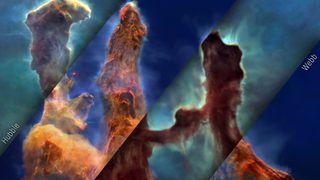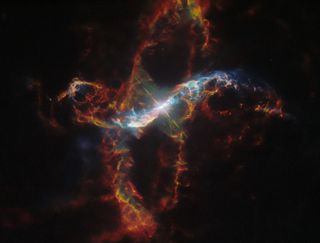Space photo of the week — Extraordinary images of our sublime universe

Space photos remind us that, around every corner of our vast universe, something spectacular awaits. From the newest James Webb Space Telescope images to historic photos of groundbreaking space missions, join us every Sunday as we explore the wonders of the universe, and humanity's place in it.
See more incredible space photos:
Latest about space photo of the week

Space photo of the week: James Webb and Chandra spot a cosmic 'Christmas Wreath' sparkling in the galaxy next door
By Jamie Carter published
There's a cosmic 'Christmas Wreath' hanging in the Small Magellanic Cloud, the James Webb and Chandra telescopes revealed in a sparkly new image.

Space photo of the week: The sun's corona blooms during back-to-back solar eclipses
By Jamie Carter published
Composite images reveal how the sun's corona changed from one total solar eclipse to another in 2023 and 2024, just as solar activity began to peak.

Space photo of the week: Astronaut spots 2 nearby galaxies from SpaceX capsule
By Jamie Carter published
NASA astronaut Don Pettit imaged the Large and Small Magellanic Clouds as the International Space Station cruised 260 miles above the Pacific Ocean.

Space photo of the week: James Webb telescope spots a secret star factory in the Sombrero Galaxy
By Jamie Carter published
This week, the James Webb Space Telescope zooms in on the iconic Sombrero Galaxy, revealing the first-ever mid-infrared observations of the hat-shaped wonder.

Space photo of the week: Hubble uncovers the true identity of an odd galaxy — and it's not spiral or elliptical
By Shreejaya Karantha published
The Hubble Space Telescope captured an image of NGC 4694, a galaxy that possesses unusual properties that complicate its classification.

Space photo of the week: Stare into the 'bloodshot eyes' of a haunting galaxy pair
By Shreejaya Karantha published
The James Webb Space Telescope and the Hubble Space Telescope recently released a chilling view of two spiral galaxies, IC 2163 and NGC 2207, merging into one.

Space photo of the week: Hubble spies a 'cannonball galaxy' blasting through space
By Jamie Carter published
The Hubble Space Telescope has captured a spiral galaxy under the "ram pressure" inside a massive cluster of galaxies.

Space photo of the week: Hubble spots a stellar 'H-bomb' exploding in Aquarius at 1 million mph
By Jamie Carter published
A pulsating red star and its spectacular nebula have been captured by NASA's Hubble Space Telescope.
Sign up for the Live Science daily newsletter now
Get the world’s most fascinating discoveries delivered straight to your inbox.


